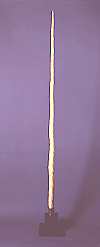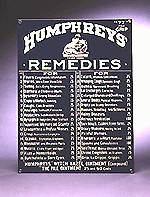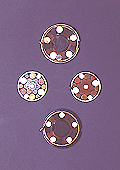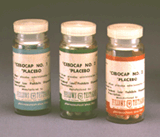






















Self-Healing, Patents, and Placebos: |
| Pharmaceutical
Era, February 1889 A model pharmacy from the late nineteenth century |

|
|
However fashionable psychosomatic medicine became, it was by no means the only way Americans pursued their interest in the relationship between emotions and disease. A long-standing tradition of mental self-help, not directed by physicians and concentrating on overt and positive rather than covert and negative feelings, began in the late nineteenth century and was still strong in the 1950s and 1960s. This tradition had consistently focused attention on proactive ways people could become more positive and optimistic about life, master their moods, and fix their physical ills without taking medications. People could align their thoughts and constructively adjust their attitudes. Because mind and body were assumed to be closely interconnected - as physician and Declaration-of-Independence-signer Benjamin Rush had clearly indicated in 1811--it was taken for granted that harmonizing one's emotions in a positive way would, unquestionably, improve one's physical well-being. |
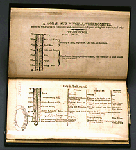 |
Benjamin
Rush (1746-1813), In the United States, efforts to articulate the relationship between the care of the body and the state of the mind, morals and emotions date back almost 200 years. |
|
This American self-help tradition first developed in New England, where it was tied in with a variety of philosophical and religious currents. 27 It spread quickly to other parts of the country, as evidenced by Julia Anderson Root's Healing Power of the Mind (first published in San Francisco in 1884) and Albert Vernon's Correspondence Course of Instruction in Psychiatrism. |
|
Julia
Anderson Root |
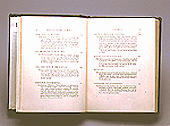
|
|
Medically-trained Harvard psychologist and philosopher William James took an active and supportive interest in what he called "The Religion of Healthy-Mindedness" which, he reported in 1902, "has recently poured over America and seems to be gathering force every day." 28 James claimed that "mind-cure gives to some of us serenity, moral poise, and happiness, and prevents certain forms of disease as well as science does, or even better in a certain class of persons." 29 Even physicians who worried about the excesses of the mind cure movement were forced to admit that cures of functional disorders often followed mind cure practice and that "physicians have failed for many years to pay sufficient attention to what may be aptly called psychical disorders of the body, or psychical conditions engendering functional derangements, or functional disturbances produced by psychical states." 30 A great concern of many turn-of-century medical practitioners, however, was that people with serious illnesses might never get to see a properly trained physician because they were so intent on curing themselves via mental self-adjustment. |
William
James 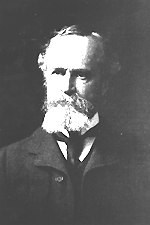
|
The blind have been made to see, the halt to walk; lifelong invalids have had their health restored.... One hears of the "Gospel of Relaxation," of the "Don't Worry Movement," of people who repeat to themselves, "Youth, health, vigor!"... William James
|
|
Despite professional anxiety and disapproval, self-healing continued to spread in the twentieth century. John Kearsley Mitchell's Self Help for Nervous Women and Charles Fremont Winbigler's How to Heal and Help One's Self are just two examples of the literally hundreds of books, manuals, and magazines that were published in the early decades. Emile Coué's technique of "autosuggestion," according to which patients affirmed to their own image in a mirror that "Day by day, in every way, I am getting better and better," was just another, mildly hypnotic self-healing ritual which became a national fad in the early 1920s. 31 The creation of Alcoholics Anonymous in the thirties as a network of self-help groups drew from these same sources. 32 By the 1940s the self-help movement took on an increasingly secular, more psychological and less religious tone. 33 Dale Carnegie's How to Stop Worrying and Start Living, Norman Vincent Peale's The Power of Positive Thinking, and Thomas Harris's I'm OK---You're OK were later representatives of the genre, as was the "Laughter is the Best Medicine" feature in Reader's Digest. The emphasis on the positive role of upbeat emotions has been continued recently in Norman Cousins's many books and articles, even though Cousins rested his self-help advice more heavily on medical authority than did most of his predecessors. 34 |
Norman
Vincent Peale (1889-1994) 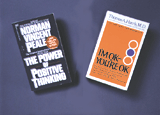 |
Reader's
Digest , April 1958 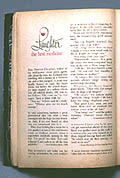 |
|
The Power of Positive Thinking, |
By the middle of the century, even such mainstream journals as Reader's Digest had absorbed the message that positive emotions were "good medicine." |
|
Focus on the salutary effect of optimism had another important consequence for medicine: it put long-standing popular enthusiasm for "cures," "remedies," devices, and so-called "patent medicines" in a new perspective. At the turn of this century, organized medicine fought a pitched battle with those purveyors of hope one historian has called the "Medical Messiahs"--and generally won, at least in the sense that in 1906 Congress endorsed the American Medical Association's campaign and passed the Pure Food and Drug Act which banned false and fraudulent advertising and labelling practices. 35 The AMA was even more effective in curbing the commercial drug market by creating its own regulatory mechanisms for product testing and surveillance and by putting pressure on newspapers and magazines to refuse lucrative advertising revenues. 36 But astute physicians realized that well into the twentieth century, people continued to purchase extraordinary quantities of worthless nostrums--"Boyd's Batteries" and even "powdered unicorn's horn"--not merely because they were gullibly manipulated by quacks and cheats but because people believed that at least a few of these products, in some sense, really "worked." Patients often felt better after following a commercially purveyed regimen or swallowing a mass manufactured tonic. In certain cases they actually did get better. "Mental medicine" of some sort, the physicians assumed, was operating behind the scenes. |
|
Warner's Safe Cure Almanac and Book of Handy Information , Buffalo, New York (right middle) from the National Library of Medicine, and a selection of "patent medicines" from the collection of Elaine and Arthur Shapiro. |
Warner's Safe Cure
Almanac 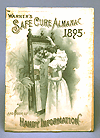
|
|
Kickapoo Oil.
Nerve & Bone Liniment. 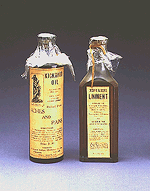 |
Bliss Native
Balsam. Swamp Root. Milks Emulsion Natures Remedy. 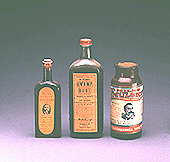 | |
| Dr. Pierce's
Favorite Prescription. Hood's Sarsaparilla, Gentian and Bitter Orange Compound. 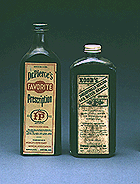 |
Powdered
unicorn horn 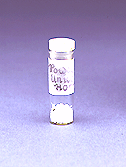 |
Erso Anti-Bilious
Bitters. Pastor Koenig's Nervine for Nervous Aliments. Goldine Tonic and Nervine. Ads Compound Syrup Hypophosphites Clear. 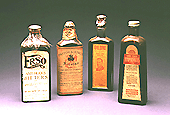 |
|
Many times before physicians had confronted the phenomenon of misplaced public trust validated by apparently successful cures. One of the more notable episodes involved a patented device called "Perkins Metallic Tractors." These little pins were advertised as curative for "topical diseases" from gout to rheumatism. Many discerning people, including George Washington, testified that the tractors worked. Dr. John Haygarth attempted to expose the fraud (he found that wooden pins worked as well as the allegedly metallic ones that were supposed to channel the body's "galvanic" electricity) in a tract entitled Of the Imagination as a Cause and as a Cure of Disorders of the Body, Exemplified by Fictitious Tractors, and Epidemical Convulsions. Haygarth's attempt to discredit a popular fad by highlighting the therapeutic role of aroused imagination was repeated by other medical authors, perhaps most impressively in the widely read Illustrations of the Influence of the Mind Upon the Body In Health and Disease, Designed to Elucidate the Action of the Imagination, written by the respected British psychiatrist Daniel Hack Tuke. Tuke exhaustively documented the Perkins episode but concluded with a critique of the medical profession. Those physicians like Haygarth who debunked Perkins by pointing triumphantly to the role of the "imagination" and then dropping the issue without seeming to care whether or not patients actually improved, displayed a behavior that struck Tuke "as astonishing as that the public should believe in, and allow themselves to be cured by, the metallic tractors." 37 By 1900 a sizeable group of American physicians regularly invoked Tuke as a weighty authority as they battled against both public credulity and seeming professional indifference to "mental medicine." |
Perkins
Metallic Tractors 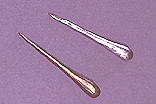
John Haygarth , Of the Imagination, as a Cause and as a Cure of Disorders of the Body; Exemplified by Fictitious Tractors, and Epidemical Convulsions, Bath, 1800 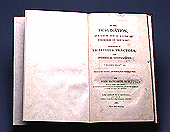 Four Batteries Perkins's Metallic tractors may have been exposed as fraudulent, but the public has repeatedly resisted the cautions of the medical establishment and continued over the years to "discover" the therapeutic power of similar kinds of objects. In this century, "Boyd's Batteries" and similar objects were worn around the neck to improve flagging energy and soothe various aches and pains |
Benjamin
Douglas Perkins (1774-1810)
The Family Remedy; or, Perkins's Patent Metallic Tractors, For the Relief of Topical Diseases of the Human Body; and of Horses, London, 1800 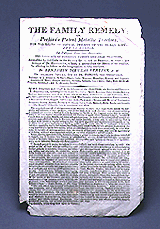
| |
Sir
William Osler (1849-1919) 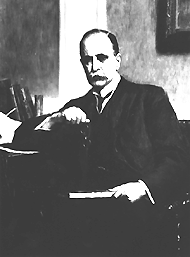
|
In the fight which we have to wage
incessantly against ignorance and quackery among the masses and
follies of all sorts among the classes, diagnosis, not drugging, is
our chief weapon of offence.
William Osler Aequanimitas,"Chauvinism in Medicine," 1904 |
|
The issue was quite complicated and compromised for physicians. Many of them were aware that they too prescribed medications whose principle basis of action was the patient's credulous belief. The term placebo was long used in medicine for a prescribed substance thought to be medically inert but helpful for cajoling or controlling neurotic patients by giving them something in which to believe and by which they might be cured. 38 The most experienced and sophisticated physicians knew that many medicines thought to be effective were really not, at least not on the basis of pharmacological principles. The regular profession was itself often guilty of over-drugging. Thus William Osler, the beloved and influential turn-of-century professor of medicine at Johns Hopkins University, could slap down quacks and jab at his colleagues at the same time by saying, In the fight which we have to wage incessantly against ignorance and quackery . . . diagnosis, not drugging, is our chief weapon of offense. Some went even further. Lewellys F. Barker, Osler's successor as professor of medicine at Hopkins, suggested that whatever success modern physicians had with their prescribed medications depended largely on their ability to awaken confidence and inspire the idea of authority by their scientific training and by their mode of inquiry and of examining the patient. 39 Even more provocatively, Harvard professor of psychiatry C. Macfie Campbell declared in a much noted 1924 lecture that physicians sometimes brought about the improvement of their patient unwittingly, when the patient is already prepared for the display of power. It is well to realize, he cautioned, that the patient who comes from afar to a great medicine-man with these wonderful machines, which extract wisdom from the air, is already half-way on the road to recovery. 40 |
| You cannot write a
prescription without the element of the placebo. A prayer to Jupiter
starts the prescription. It carries weight, the weight of two or
three thousand years of medicine.
Eugene F. Dubois "The Use of Placebos in Therapy," Cornell Conferences on Therapy, 1946 |
|
Thus the groundwork was laid for the serious investigation of the role of hope, imagination and expectation in the operation of medications and procedures in scientific medicine. W.R. Houston defined the issue clearly in a 1937 address to the American College of Physicians when he said, "The great lesson . . . of medical history is that the placebo has always been the norm of medical practice." 41 Eugene F. Dubois, professor of medicine at Cornell University, expressed similar sentiments in 1946. By this time drug companies were marketing code-named placebos for use in clinical practice. Soon afterwards, scientists conducted experiments on placebo effects. This coincided, not accidentally, with the period when the pharmaceutical industry was producing penicillin and other "wonder" drugs whose full power and range of action had not yet been tested and when psychosomatics had become a central concern of mainstream medicine. 42 Rigorous studies, often measuring placebo effects in experimental drug trials, multiplied rapidly, more being published in the four years from 1954 to 1957 than in all prior years combined. In 1955 one of the leading young investigators, Louis Lasagna, was invited to write about placebos in Scientific American, a clear sign that the field had "arrived." 43 |
Antilirium
Placebo 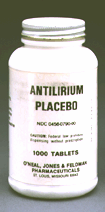 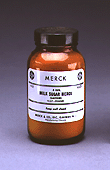
|
Cebocap
Placebos
Placebos were produced for clinical use in a range of different shapes and colors, and physicians even discused which colors and shapes worked best. Bottles were labled with simple code names (Cebocap, Obecalp) so patients would not catch on to the fact that they were being given a placebo rather than a real drug. Milk Sugar (or lactose) was the classic placebo that physicians sometimes used in their clinical practice. This bottle of milk sugar placebos was produced for clinicians by Merck Pharmaceuticals. |
|
Jon
D. Levine , Newton C. Gordon and Howard L. Fields, |
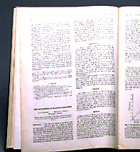
|
|
Serious work on placebos continued over the next two decades. Investigators pursued many fruitful lines of research, but two of the most productive turned out to be the exploration of psychological mechanisms in experimental subjects identified as "placebo reactors" 44 and the specification of the brain biochemistry which underlay placebo effects. 45 In one of the most suggestive studies in this second line of research, published in The Lancet, Levine, Gordon, and Fields concluded that the activity of "endogenous opioids"(the body's own opium-like substances) accounts for "placebo analgesia." Although there are many unanswered questions, by the late 1970s it appeared as if both clinicians and basic scientists had accepted the placebo effect as a central phenomenon in medicine--indeed, as one of the body's arsenal of self-protective weapons--and thought it ultimately explicable in the most modern biochemical terms. |
Placebos
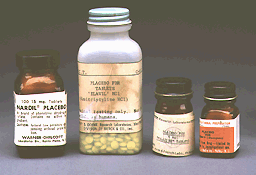 |
By the 1950s, medical researchers began to use placebos in a different way. In drug trials, they gave some patients active medications and others dummy drugs that looked identical--and then compared the therapeutic results. The idea was not to learn about the placebo effect in its own right, but to sort out the "real" effect of an active drug from the "merely psychological" effect of its placebo. Pharmaceutical companies produced these placebos in the 1960s for use in testing a range of antidepressant medications. | |

|
